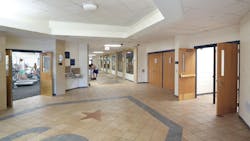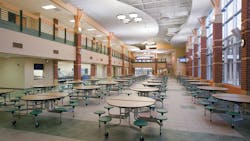The constant barrage of media, debates, panels, task forces and politics on the topic of utility rates and consumption demonstrates the important role that energy plays in today’s society. Furthermore, as prices at the gas pumps climb again, energy costs are on the forefront of our minds … personally and hopefully for schools. But, when it comes to your education institution: Are you reactive? Is your strategy proactive? Are you considering the right elements to develop a plan to lower energy costs?
With purposeful direction, schools and universities can take steps that will chip away at energy costs, making a direct impact on an institution’s bottom line.
Monitor and Benchmark Energy Usage
Understanding a school’s energy consumption goes way beyond looking at the bills at the end of each month. The first resource to consider is the historical data of energy consumption for the properties, preferably over numerous years and with specific information on each facility. The accounting office or energy provider typically can provide such information.
The second source of information schools should seek is quality benchmarking. This enables institutions to compare performance against expectations and in relation to comparable buildings. State education agencies, regional energy-focused groups and websites such as www.energystar.gov/benchmark can provide critical data, often broken down by facility type, to provide quality framework by which to compare.
Once the data is gathered, the team can take on the role of sleuths--looking for performance patterns and comparing those with the available benchmarks. This process can identify areas for improvement, as well as discover successful existing practices and measures. The most accurate way to establish these head-to-head comparisons is by matching electric and gas consumption on a per-square-foot basis (adjusted for heating and cooling degree days) with other similar school facilities.
Experience has shown that few schools are truly monitoring and benchmarking their energy and water consumption. Those that do are ahead of the curve.
Examine Basic Efficiency Measures
When it comes to lowering energy consumption, it is vital to evaluate a building’s performance, especially with the heating, ventilating and air conditioning (HVAC) system. It is best to compare the building’s performance to an energy model, as well as to comparable institutions in the area. The efficient design and operation of an HVAC system plays a starring role in reducing energy costs and consumption over the life span of the facilities. High-performance HVAC and lighting systems not only provide a good return on investment, but also positively affect students’ environment by providing better air quality and an enhanced learning-conducive setting because of a more consistent temperature.
Another tool in the battle against rising energy costs is commissioning. Commissioning is a systematic quality-assurance process used to ensure that building systems operate according to the district or campus’ operational needs and the original design intent. This service, performed by a third-party commissioning agent, ensures that school districts achieve the performance and design for which they paid. Although some believe that commissioning is a superfluous cost, time has demonstrated that it brings great value for new or remodeled buildings as well as existing facilities, where the process is called retro-commissioning.
With quality commissioning and open lines of communication, project teams can consistently improve the ongoing performance of a school facility. Maximizing performance also requires that facilities teams are well-equipped to operate the new or remodeled building, and are given the right information and training. Ongoing improvements and utility savings are likely to occur for the first few years of operation of new facilities, as tweaks are made to fine-tune performance.
Strategizing the Energy Supply Mix
Is your institution writing checks every month without giving careful consideration to what is the right energy source for the area at this time? Many changes in availability and rates have taken place in recent years; the right energy choice five years ago may not be the best choice today. In fact, what is right today may not be the best in the ensuing years. It is important to change with the times and think out-of-the-box about energy choices.
The cost of natural gas has plummeted because of the growth of new natural gas resources, much of which is associated with fracking … a significant revolution in the last few years. It is likely that natural gas will remain at very low rates for the next few years. Similarly, some pockets of the country enjoy low-cost electricity, while others are watching those rates rise with staggering speed. Other schools are still using fuel oil and propane.
Schools should be familiar with the options and have a strategy. It is important to weigh all of the options, looking for the pros and cons and what is the wisest direction for the specific campus or school district.
Consider Producing Energy
The cost of renewable (solar and wind) energy has dropped significantly and is now a viable option for some school systems. Third-party financing is a possibility for these systems in some states, taking advantage of the new tax laws where the tax credits and accelerated depreciation schedules can be used by third parties. It is feasible to see a day when some schools would have greatly reduced energy costs because they own their renewable-energy systems and have them paid off.
Third-party financing is emerging as a desired method of financing renewable-energy generation and some efficiency improvements. Third-party financing measures are especially attractive for schools because they cannot claim tax credits and they often lack the initial investment capital to purchase a solar or wind system. With this arrangement, investors monetize available incentives such as rebates, tax credits and depreciation. The school system/host site provides the space to investors for a privately owned and operated system. This model provides schools the opportunity to enter the renewable energy market where they otherwise don’t have the upfront capital. Some schools are exploring a net-zero-energy target—producing as much energy as they need over the course of a year.
Sidebar: Commissioning Works
One example of the benefits of commissioning took place at Northland Pines High School, Eagle River, Wis., about five months into its operation. The commissioning agent recognized that the building was operating well, but not quite at peak performance.
In the discovery process, the four energy-recovery units were examined. As the mystery unraveled, two of the heat wheels (which happen to be about the size of a living room) were found to not be operating at the speed they should be.
The culprit was discovered: two wires were crossed, and thus several sensors were giving inaccurate readings. Corrections were made, and performance was enhanced.
As in this case, often some detective work must be done to “fine tune” each and every school to be certain that it operates in the most effective manner and the savings are fully realized.
Hanson, LEED AP BD+C, is director of sustainable services for Hoffman Planning, Design and Construction, Inc., Appleton, Wis.

